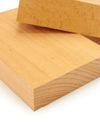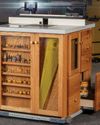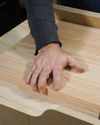
Even though it is sometimes called white or blonde walnut, to dismiss butternut as simply an under-pigmented version of black walnut is to do it a disservice. The grain structure of the two species is similar as is the appearance of the source trees, so you can see how the comparison was drawn. But there are some significant differences. Obviously, butternut's tawny coloring is quite different from walnut. It is also softer, lighter in weight, a bit weaker, and less expensive. As I'll explain, these differences are what set the species apart and make it worthy of consideration for a variety of projects. I am also saddened to tell you that this noble species is threatened across its range.
Where the wood comes from
Butternut (Juglans cinerea) is a denizen of eastern North America. While old-growth trees used to reach impressive size 4'+ in diameter and 100'+ tall, today's butternut trees are smaller-up to 2' in diameter and 40-60' tall-and only grow in about 10% of their former range. The species is not listed on either the CITES or IUCN Red List, but that may soon change. The trees are suffering from a widespread fungal disease called "Butternut Canker" that is worrisome enough that the US Fish and Wildlife Service has listed it as a "species of federal concern." When and while you can still find it, butternut is available as lumber in thicknesses from 4/4 - 16/4, in widths typically from 4-10" and in lengths to 12'. Pricing is generally under $10/board foot. Butternut plywood and veneer are also available.
History in woodworking
この記事は Woodcraft Magazine の August - September 2022 版に掲載されています。
7 日間の Magzter GOLD 無料トライアルを開始して、何千もの厳選されたプレミアム ストーリー、9,000 以上の雑誌や新聞にアクセスしてください。
すでに購読者です ? サインイン
この記事は Woodcraft Magazine の August - September 2022 版に掲載されています。
7 日間の Magzter GOLD 無料トライアルを開始して、何千もの厳選されたプレミアム ストーリー、9,000 以上の雑誌や新聞にアクセスしてください。
すでに購読者です? サインイン

Beech
Plain looks, but a solid performer

Working with PLASTIC LAMINATE
Adding a durable, smooth, and colorful surface to your work

High-Tech ROUTER TABLE
A state-of-the-art shop essential

Albers-Inspired NESTING TABLES
A colorful array of Bauhaus utility

Desktop ORGANIZERS
Mini modules for your modern workspace

Joiner's MALLET
A hard-hitting shop hammer

Battery-backed biscuiting
DeWalt 20V Max XR Biscuit Joiner

Crosscut SLED
A basic build of a crucial table saw accessory

Power-carving BOWLS
Tools and techniques for sculpting

Library STEPS
Mitered box joints give rise to an updated classic